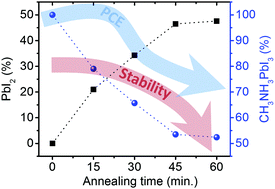The role of PbI2 in CH3NH3PbI3 perovskite stability, solar cell parameters and device degradation†
Abstract
We report a systematic investigation on the role of excess PbI2 content in CH3NH3PbI3 perovskite film properties, solar cell parameters and device storage stability. We used the CH3NH3I vapor assisted method for the preparation of PbI2-free CH3NH3PbI3 films under a N2 atmosphere. These pristine CH3NH3PbI3 films were annealed at 165 °C for different time intervals in a N2 atmosphere to generate additional PbI2 in these films. From XRD measurements, the excess of PbI2 was quantified. Detailed characterization using scanning electron microscopy, X-ray diffraction, UV-Visible and photoluminescence for continuous aging of CH3NH3PbI3 films under ambient condition (50% humidity) is carried out for understanding the influence of different PbI2 contents on degradation of the CH3NH3PbI3 films. We find that the rate of degradation of CH3NH3PbI3 is accelerated due to the amount of PbI2 present in the film. A comparison of solar cell parameters of devices prepared using CH3NH3PbI3 samples having different PbI2 contents reveals a strong influence on the current density–voltage hysteresis as well as storage stability. We demonstrate that CH3NH3PbI3 devices do not require any residual PbI2 for a high performance. Moreover, a small amount of excess PbI2, which improves the initial performance of the devices slightly, has undesirable effects on the CH3NH3PbI3 film stability as well as on device hysteresis and stability.



 Please wait while we load your content...
Please wait while we load your content...